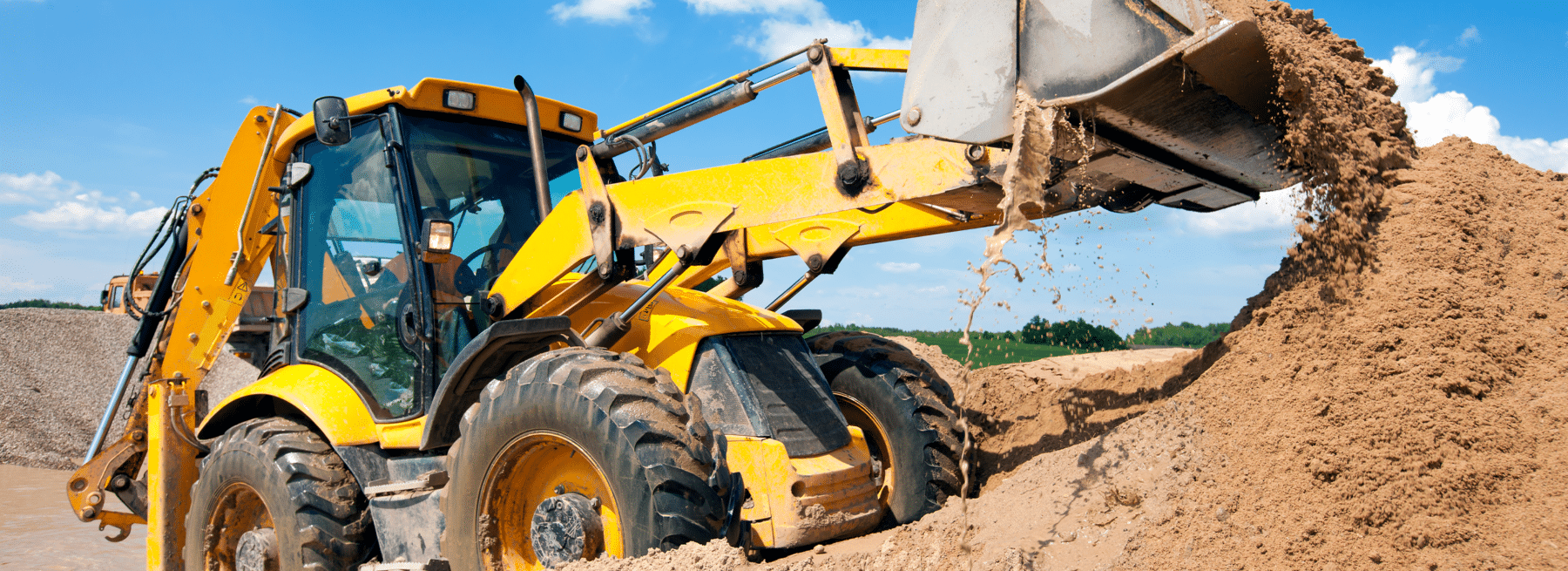Working with heavy equipment is a critical part of various industries such as construction and manufacturing. While these machines have a pivotal role in increasing productivity and efficiency, they also pose significant dangers to those who operate them or work nearby. The massive size, power, and complexity of heavy equipment can make the workplace a hazardous environment, demanding heightened vigilance and adherence to safety protocols.
In the world of construction and industrial settings, leaders must navigate the fine line between getting the job done efficiently and ensuring the safety of workers. Understanding the top dangers associated with heavy equipment will help company leaders be confident that they implement the right safety precautions to minimize risks to workers’ health.
Understanding the Risks of Working with Heavy Equipment
The massive size, power, and complexity of heavy equipment can turn construction sites, manufacturing facilities, and other settings of a similar nature into a hazardous environment. It demands heightened vigilance and adherence to safety protocols.
Working with heavy equipment requires an acute awareness of the many dangers that can arise in these settings. While the power and efficiency of these machines are undeniable, they come with inherent risks that call for diligent management.
One of the most pressing dangers is the potential for heavy machinery to malfunction or break down during operation. These unexpected failures can result from various factors, including wear and tear, insufficient maintenance, or technical faults. When these issues manifest, they can disrupt productivity and create immediate safety hazards to the operators and those in the vicinity.
Furthermore, the high level of noise generated by heavy equipment can have long-term health consequences for those exposed to it. Prolonged exposure to this noise can lead to hearing changes, impacting the overall well-being of workers.
Alongside noise, vibrations from heavy machinery can contribute to musculoskeletal disorders, causing discomfort and potential injuries. It is imperative that workplaces incorporate measures to minimize these effects, such as providing adequate hearing protection, scheduling regular breaks, and ensuring that operators have access to ergonomically designed seats, controls, and proper personal protective equipment (PPE) to reduce the impact of vibrations.
Another risk associated with heavy equipment operations is the potential for fires and explosions. These machines often use flammable fuels, hydraulic fluids, and lubricants, making them susceptible to ignition in the presence of sparks, extreme heat, or electrical faults.
Top 6 Risks of Using Heavy Equipment
Along with safety training, workers need training on fire hazards. It’s also important to have well-maintained fire extinguishing equipment readily available. Strict safety protocols should be in place to help prevent, detect, and rapidly respond to potential fire-related incidents, reducing the risk of catastrophic accidents. Here are the top six dangers that come with jobs that work around heavy equipment.
1. Machine accidents
Heavy equipment, including bulldozers, excavators, and cranes, can cause severe accidents when workers do not follow proper operation procedures. Mishaps may occur due to equipment malfunctions, lack of proper training, or operator error.
Heavy equipment needs to have machine guards. These help protect against hazards. However, some heavy equipment operators do not know how to use or check the machine guards. In some cases, the machine guards aren’t on the equipment. The consequences of these accidents can range from minor injuries to fatalities.
2. Falls and collapses
Working at heights or on elevated platforms around heavy equipment can lead to falls. Scaffolds, bucket lifts, and aerial platforms present fall risks. Additionally, improperly secured loads on cranes or forklifts can collapse, endangering workers beneath or in the vicinity.
3. Struck-by or caught in-between accidents
Workers close to heavy equipment are at risk of being run over or hit by moving parts, swinging loads, or the equipment itself. Inattention, lack of communication, or unseen views can contribute to these accidents.
Workers can become trapped between heavy equipment, machine parts, or materials being handled. This danger is particularly pronounced in confined spaces or during maintenance and repair work.
4. Electrocution
Heavy equipment can come into contact with power lines, leading to electrical shocks or electrocution. Failure to identify and maintain safe distances from electrical sources can result in severe injuries or fatalities.
5. Noise and vibration hazards
Prolonged exposure to the noise and vibrations generated by heavy equipment can lead to hearing loss, musculoskeletal disorders, and other health problems for workers. Proper personal protective equipment (PPE) and equipment maintenance are crucial to help mitigate these risks.
Workers need to have the correct PPE for the activities. They also need training in how to use them. PPE is the area where companies should not go cheap. They need to invest in the correct PPE for the task. One pair of gloves is not meant to be used in all tasks. Different tasks require different types of gloves.
6. Failure to receive proper training on heavy equipment
It’s critical to never take for granted that workers know the proper procedures. They can grow complacent over time. They may have been trained in a different brand of heavy equipment. They may have never undergone training. Leaders need to avoid assuming workers have gotten proper training in their previous jobs.
Not addressing these dangers can result in loss of life. This is the one thing that cannot be replaced. Injuries from heavy equipment accidents can also cause permanent disabilities, such as burns, traumatic brain injuries, and amputation. Investing in steps to help prevent these is a small price to pay to avoid paying a bigger price.
Viewing Heavy Equipment Safety as an Investment
Companies that rely on heavy equipment have a responsibility to ensure they’re complying with laws and regulations. Besides, heavy equipment safety is an ethical and moral imperative. Companies that emphasize safety are showing their commitment to the well-being of their employees and contractors.
Remember that every worker, operator, and laborer, has a family. They may have parents, children, siblings, and friends who count on them to come home after finishing a day’s work. Prioritizing heavy equipment is an investment in the future of the company. A company with a robust safety culture builds trust and attracts talent.
Employees, operators, and laborers want to work for a company that values their lives and health. This attitude goes a long way in increasing morale and job satisfaction. Considering many industries that depend on heavy equipment have a shortage of workers. They are all competing for skilled workers. A high focus on safety can differentiate a company. They will be able to attract and retain top talent.
Another benefit of having a strong safety track record is that they’ll be more likely to catch the interest of more clients and partners. These clients and partners want to work with companies that have a commitment to quality and reliability without sacrificing safety. Thus, heavy equipment safety is about building a safer, more resilient, and more successful company for everyone involved.
In addition to protecting lives, heavy equipment safety helps reduce heavy equipment downtime. Just like humans need annual physicals and cars undergo yearly maintenance, heavy equipment needs to be properly maintained. Proactive maintenance can extend the life of the equipment and reduce the chances of breaking down due to wear and tear. Heavy equipment tends to have start-up and shutdown processes. These need to be followed every single day.
Following the steps for using heavy equipment and consistent maintenance avoids the high costs associated with repairs and replacements.
How to Increase Safety in Working with Heavy Equipment
To help ensure the safety of workers in environments where heavy equipment is present, it is vital to implement comprehensive safety measures. Training is one of the crucial ways to help protect workers from heavy equipment dangers. Heavy equipment operators should receive proper training and certification. They need to know how to use the controls, how to react to different situations, understand the limitations, and how to avoid run-ins with nearby workers.
As previously stated, regular equipment maintenance can help prevent malfunctions and breakdowns. Using an asset management app can help automate the maintenance reminders process and keep current information on all equipment.
Personal protective equipment (PPE) needs to be a priority. Workers need to have the appropriate PPE for the tasks as well as standard PPE like hard hats, high-visibility clothing, and steel-toed boots.
The communication process is another critical component of ensuring worker safety. Signalers, two-way radios, and visual indicators like hand signals can help prevent accidents by ensuring that operators are aware of the presence and movements of other workers. If workers’ first language is different than the company’s language, then they should have a translator for all safety-related briefings and training.
Define safety zones by installing physical barriers, warning signs, and audible alarms. Modern heavy equipment often contains safety features like backup alarms and proximity sensors. For height-related tasks, incorporate fall protection systems such as guardrails, personal fall arrest systems, and safety nets. These can help prevent falls and their potentially catastrophic consequences.
It’s tempting to pack as much as possible onto a load. But that can cause loads to shift or collapse. Training in safe loading and unloading procedures is necessary for those handling materials. This helps ensure proper load securing and weight distribution.
The company needs to have clear guidelines for maintaining safe distances from power lines. Workers need to know these guidelines and be trained to recognize potential electrical hazards.
Protect hearing and musculoskeletal systems by implementing noise and vibration control measures. These include limiting exposure time, providing hearing protection, and using anti-vibration gloves and seats where appropriate.
And finally, install security cameras around the facility and site. Ensure there are trained monitoring operators watching the cameras. They can view the property and report potential problems such as safety hazards and improper procedures. They can also help deter crime and protect assets.
Heavy equipment plays a critical role in many industries. However, it comes with inherent dangers that can lead to accidents, injuries, and even fatalities. By understanding the risks associated with heavy equipment and implementing robust safety measures, you can minimize these dangers and create a safer working environment for everyone involved. Always prioritize safety. Remember that it’s better to be cautious than to risk the consequences of overlooking these risks.
To learn more about the use of remote video surveillance to improve safety, check out the guide to monetizing security while balancing access, safety, and profitability. For a customized safety video surveillance system that fits your budget and requirements, contact us.
Texas Private Security License Number: B14187
California Alarm Operator License Number: ACO7876
Florida Alarm System Contractor I License Number: EF20001598
Tennessee Alarm Contracting Company License Number: 2294
Virginia Private Security Services Business License Number: 11-19499
Alabama Electronic Security License # 002116
Canada TSBC License: LEL0200704

